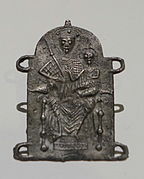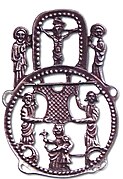Pilgrim sign

Pilgrim characters (also known as pilgrim marks hereinafter) badge, usually in the form of small plaques , medals or flat castings from a lead - tin - alloy which predominantly in middle age in sanctuaries sold and on the pilgrimage were worn on the hat or clothing.

Volume and usage
Even the early Christians sought out special places, such as the tomb of Christ or the burial places of the apostles , to pray there. These places were mostly in the Holy Land or in Rome and can be described as the first places of pilgrimage. Towards the end of the early Middle Ages , the pilgrimage spread massively, so from around 900 AD a lively pilgrimage to the grave of St. James in Santiago de Compostela developed . From the 11th century, other pilgrimage sites were added in Central Europe.
The pilgrims felt the need to be able to take a memory of the pilgrimage with them; on the one hand as a sign of piety, but also as evidence that one had actually been to the holy place. Already earlier there was the custom of taking pilgrim souvenirs with you from the pilgrimage site, the meaning of which was similar to the later pilgrimage signs. These could be relics in the narrower sense, contact relics or generally local objects of the respective holy place. In the course of the 12th century, the tradition of handing out small badges at the pilgrimage sites developed. However, the pilgrim signs were not legally recognized proof of the visit to the pilgrimage site, especially since forgeries were also circulating, i.e. brands of one place of remembrance were partly produced and sold elsewhere. As a rule, the pieces were sold to the pilgrims, sometimes also to be given out after the pilgrims' blessing.
The pilgrimage symbols either depict the saint or his attributes, relics venerated there or the sanctuary itself. The best-known example is the scallop shell as a badge for the pilgrimage to Santiago de Compostela. Further examples are images of Peter and Paul for the pilgrimage to Rome or the Three Wise Men for the pilgrimage to Cologne . In addition to their function as mementos , they were also assigned a miraculous effect that was directly related to the venerated saint. The belief in the healing effects went so far that the pilgrim's mark was placed on a sick part of the body for healing. Likewise, the sick were given water or wine to drink in which the badge had been dipped. The medals were also considered amulets to ward off evil and were hung in the house or stable or buried in the field for this purpose . In addition, they protected the porter on his journey, as pilgrims were under special religious protection and were not allowed to be attacked. Especially from the 14th century, pilgrimage signs were also cast on church bells . Behind this was the belief that the beneficial effect of the saint should spread over the country with the sound of the bell.
Manufacturing
Undoubtedly, the manufacture and sale of pilgrim signs was a profitable business that contributed significantly to the wealth of some pilgrimage sites. They are usually the material is a lead - tin - alloy , but there were also more costly variants of noble metals such as silver or gold. Characteristic are small eyelets on the edges with which the objects could be attached to the pilgrim's clothing or headgear. Initially, the objects were made of flat cast, usually with a smooth back, but in the course of the 14th century they became more filigree and were often perforated (cast lattice). In some places they were painted in color, as can be seen from representations on paintings and individual preserved pieces (for example one painted red in Wilsnack). The size of the characters fluctuates by around 4 × 4 cm; they are rarely much larger.
In addition to the tin / lead pilgrim signs, other materials were occasionally used: for example, the use of scallops as a pilgrim sign was relatively widespread , as the shell was an attribute of the apostle and Saint James the Elder , the patron saint of pilgrims. The shells were particularly typical as a pilgrimage sign for a pilgrimage to Santiago de Compostela , where the grave of St. James was an important pilgrimage site. The pilgrim horns as they were distributed in Aachen and the pilgrimage mirrors also played a role comparable to the pilgrim stamps . Badges embossed in sheet metal appeared for a short time around 1490.
Pewter and lead pilgrim's mark, found at the Hagenmarkt in Braunschweig
A copper alloy pilgrimage sign , probably depicting Saint Thomas Becket
Pilgrim's mark depicting Saint Prokop of Sázava , found in Karlova Huť (example of cast iron)
Development and exploration
The custom of the pilgrim sign reached its peak in the 14th and 15th centuries. In 1466, 130,000 pilgrim signs were sold in the Einsiedeln monastery within two weeks, in 1519 and 1520 sales of 119,370 pilgrim signs made of lead and 12,193 pieces of silver were recorded during the pilgrimage to the "Beautiful Maria" in St. Kassian in Regensburg . Around 1530, everywhere in Central Europe, including in Catholic areas, the issue of pilgrimage signs came to a standstill. In some regions, however, the belief in the protective effect of pilgrimage signs lives on to this day.
For historians , finds of pilgrimage signs - for example as grave goods - are important, as they are suitable for documenting pilgrimage and travel routes in the Middle Ages. Larger collections of pilgrims' marks are to be found in the Germanisches Nationalmuseum in Nuremberg , the Focke Museum Bremen, the Museum of London or the Musée national du Moyen Age in Paris .
literature
- Christoph Daxelmüller , Marcell Restle : pilgrim souvenirs sign cited . In: Lexicon of the Middle Ages (LexMA). Volume 6, Artemis & Winkler, Munich / Zurich 1993, ISBN 3-7608-8906-9 , Sp. 2154-2156 mainly on other forms of pilgrimage souvenirs.
- Kurt Köster : Pilgrim Sign Studies. New contributions to the knowledge of a mediaeval mass article and its forms of transmission. In: Bibliotheca docet. Ceremony for Carl Wehmer. Amsterdam 1963, pp. 77-100.
- Kurt Köster: Pilgrim signs and pilgrim shells. In: Sankt Elisabeth: Princess, servant, saint. Articles, documentations, catalog (of the exhibition on the 750th anniversary of the death of St. Elisabeth, Marburg). Sigmaringen 1981, pp. 452-459.
- Hartmut Kühne, Lothar Lambacher, Konrad Vanja (eds.): The symbol on the hat in the Middle Ages. European travel markings. Symposium in memoriam Kurt Köster (1912–1986) and catalog of the pilgrim signs in the Kunstgewerbemuseum and in the Museum of Byzantine Art of the State Museums in Berlin (= European pilgrimage studies. Volume 4 / = Series of publications Museum European Cultures. Volume 5). Peter Lang, Frankfurt am Main et al. 2008, ISBN 978-3-631-57408-9 .
- Hartmut Kühne, Lothar Lambacher, Jan Hrdina (eds.): Pilgrims from the East. Medieval pilgrim signs between the Baltic Sea, Danube and Seine. Contributions to the conference Perspectives on European Pilgrimage Research April 21 to 24, 2010 in Prague (= European Pilgrimage Studies. Volume 10). Peter Lang, Frankfurt am Main et al. 2010, ISBN 978-3-631-62147-9 .
- Hartmut Kühne, Klaus Herbers (ed.): Pilgrim signs - "Pilgrim roads". Gunter Narr Verlag, Tübingen 2013.
- Jörg Poettgen: European pilgrimage research. The Central Pilgrim Sign Index (PZK) Kurt Kösters († 1986) in Nuremberg and the state of research after 1986. In: Yearbook for bell customers. Volume 7/8, 1995/1996 (published 1997).
Web links
- Pilgrim sign database of the Humboldt University, Berlin
- Pilgrimage database of Radboud University Nijmegen, Netherlands
Individual evidence
- ↑ Christoph Daxelmüller : pilgrim souvenirs, I sign cited . In: Lexicon of the Middle Ages (LexMA). Volume 6, Artemis & Winkler, Munich / Zurich 1993, ISBN 3-7608-8906-9 , Sp. 2154 f.
- ^ Robert Plätz: Signum peregrinationis. Sacred memory and spiritual protection. In: Hartmut Kühne, Lothar Lambacher, Konrad Vanja (eds.): The symbol on the hat in the Middle Ages. European travel markings. Peter Lang, Frankfurt am Main et al. 2008, ISBN 978-3-631-57408-9 , pp. 47–70, here pp. 54–57.
- ↑ a b c Robert Plätz: Signum peregrinationis. Sacred memory and spiritual protection. In: Hartmut Kühne, Lothar Lambacher, Konrad Vanja (eds.): The symbol on the hat in the Middle Ages. European travel markings. Peter Lang, Frankfurt am Main et al. 2008, ISBN 978-3-631-57408-9 , pp. 47-70, here p. 69.
- ↑ Overview of this phenomenon and its research: Jörg Poettgen: The contribution of the bell science to pilgrimage research from Kurt Köster until today. In: Hartmut Kühne, Lothar Lambacher, Konrad Vanja (eds.): The symbol on the hat in the Middle Ages. European travel markings. Peter Lang, Frankfurt am Main et al. 2008, ISBN 978-3-631-57408-9 , pp. 31-46.
- ^ Andreas Haasis-Berner: The pilgrimage in the 14th century as reflected in the pilgrimage. A thesis on the history of pilgrimage in the Holy Roman Empire of the German Nation. In: Hartmut Kühne, Lothar Lambacher, Konrad Vanja (eds.): The symbol on the hat in the Middle Ages. European travel markings. Peter Lang, Frankfurt am Main et al. 2008, ISBN 978-3-631-57408-9 , pp. 143–151, here p. 144.
- ^ Robert Plätz: Signum peregrinationis. Sacred memory and spiritual protection. In: Hartmut Kühne, Lothar Lambacher, Konrad Vanja (eds.): The symbol on the hat in the Middle Ages. European travel markings. Peter Lang, Frankfurt am Main et al. 2008, ISBN 978-3-631-57408-9 , pp. 47–70, here pp. 58–68.
- ↑ Christoph Daxelmüller : pilgrim souvenirs, I sign cited . In: Lexicon of the Middle Ages (LexMA). Volume 6, Artemis & Winkler, Munich / Zurich 1993, ISBN 3-7608-8906-9 , Sp. 2154 f. , here col. 2155.
- ↑ Carina Brumme: Pilgrim Signs - Conservation Conditions and Distribution Areas. In: Hartmut Kühne, Lothar Lambacher, Konrad Vanja (eds.): The symbol on the hat in the Middle Ages. European travel markings. Peter Lang, Frankfurt am Main et al. 2008, ISBN 978-3-631-57408-9 , pp. 127-142.







